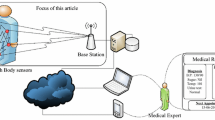Abstract
We study the potential of cognition and cooperation in Body Area Networks (BANs). On one hand, most BAN-based applications involve end-to-end transmission across heterogenous networks. Cognitive communication has been known to be an effective technology for addressing network heterogeneity. On the other hand, a BAN is normally required to provide reliable communications and operate in a very low power level to conserve energy and reduce the electromagnetic radiation impact on human body. Cooperative communication has been known to enhance the transmission reliability and maintain low transmission power. However, the joint cognitive and cooperative mechanism has not been investigated yet in the literature. In this paper, we propose a network architecture for cognitive and cooperative communications in BANs. An intelligent mobile device is introduced as either a cognitive gateway to interconnect heterogenous networks; or a cooperative relay node to achieve transmission diversity. Two cooperative transmission schemes, Energy-conserved Cooperative Transmission and Reliability-driven Cooperative Transmission, are presented for different applications that have distinct energy consumption or reliability requirement. Optimization problems are formulated to optimally allocate power in the cooperative transmission. Results indicate that cooperative transmission schemes can significantly decrease Bit Error Rate (BER) and reduce energy consumption, compared to the non-cooperative schemes. The BER gain is over one order in the high SNR region, while the energy consumption can save up to 50% in the low BER region.













Similar content being viewed by others
References
Chen M, Gonzalez S, Vasilakos A, Cao H, Leung V (2010) Body area networks: a survey. ACM/Springer Mob Netw Appl (MONET). doi:10.1007/s11036-010-0260-8
Hanson M et al (2009) Body area sensor networks: challenges and opportunities. Computer 42:58–65
Jurik AD et al (2009) Body sensors: wireless access to physiological data. IEEE Softw 26:71–71
Chen M, Gonzalez S, Zhang Q, Li M, Leung V (2010) A 2G-RFID based E-healthcare system. IEEE Wirel Commun Mag 17(1):37–43
Taleb T, Bottazzi D, Guizani M, Nait-Charif H (2009) Angelah: a framework for assisting elders at home. IEEE J Sel Areas Commun 27(4):480–494
Chen Y, Teo J, Lai J, Gunawan E, Low K, Soh C, Rapajic P (2009) Cooperative communication in ultra-wideband wireless body area networks: channel modeling and system diversity analysis. IEEE J Sel Areas Commun 27:5–16
Yu R, Zhang Y, Gao R (2010) Mobile device aided cooperative transmission for body area networks. In: BODYNETS
Lin X, Lu R, Shen X, Nemoto Y, Kato N (2009) Sage: a strong privacy-preserving scheme against global eavesdropping for ehealth systems. IEEE J Sel Areas Commun 27(4):365–378
Su H, Zhang X (2009) Battery-dynamics driven TDMA MAC protocols for wireless body-area monitoring networks in healthcare applications. IEEE J Sel Areas Commun 27(4):424–434
Van Roy S, Oestges C, Horlin F, De Doncker P (2007) Ultra-wideband spatial correlation study for multi-sensor multi-antenna body area networks. In: Proc. IET seminar on antennas and propagation for body-centric wireless communication, UK, pp 67–70
Fort A, Ryckaert J, Desset C, De Doncker P, Wambacq P, Van Biesen L (2006) Ultra-wideband channel model for communication around the human body. IEEE J Sel Areas Commun 24(4):927–933
Alomainy A, Hao Y, Hu X, Parini CG, Hall PS (2006) UWB onbody radio propagation and system modelling for wireless body-centric networks. IEE Proc Commun 153(1):107–114
Wang C-X, Patzold M, Yao Q (2007) Stochastic modeling and simulation of frequency correlated wideband fading channels. IEEE Trans Veh Technol 56(3):1050–1063
Chavez-Santiago R, Khaleghi A, Balasingham I, Ramstad TA (2009) Architecture of an ultra wideband wireless body area network for medical applications. In: 2nd international symposium on applied sciences in biomedical and communication technologies, ISABEL
Li H-B, Takizawa K-i, Bin Z, Kohno R (2007) Body area network and its standardization at IEEE 802.15.BAN. In: 16th IST mobile and wireless communications summit
Drude S (2007) Requirements and application scenarios for body area networks. In: 16th IST mobile and wireless communications summit
Chiti F, Fantacci R, Archetti F, Messina E, Toscani D (2009) An integrated communications framework for context aware continuous monitoring with body sensor networks. IEEE J Sel Areas Commun 27(4):379–386
Xie S, Liu Y, Zhang Y, Yu R (2010) A parallel cooperative spectrum sensing in cognitive radio networks. IEEE Trans Veh Technol 59(8):4079–4092
Haykin S (2005) Cognitive radio: brain-empowered wireless communications. IEEE J Sel Areas Commun 23(2):201–220
Yu R, Zhang Y, Huang M, Xie S (2010) Cross-layer optimized call admission control in cognitive radio networks. ACM/Springer Mob Netw Appl (MONET) 15(5):610–626
Xiang J, Zhang Y, Skeie T (2010) Medium access control protocols in cognitive radio networks. Wiley Wirel Commun Mob Comput (WCMC) 10(1):31–49
Astrin A, Aoyagi T, Cho C et al (2009) channel model for body area network (BAN). In: IEEE P802.15-08-0780-09-0006
Zin MSIM, Hope M (2010) A review of UWB MAC protocols. In: 2010 sixth advanced international conference on telecommunications, pp 526–534
Acknowledgements
The work in this paper is partly supported by programs of NSFC under Grant nos. 60903170, U0835003, U1035001; the Specialized Research Fund for the Doctoral Program of Higher Education (SRFDP, no. 20090172120010); the Fundamental Research Funds for the Central Universities, SCUT (no. 2009ZM0250); and the Foundation for Distinguished Young Talents in Higher Education of Guangdong, China.
Author information
Authors and Affiliations
Corresponding author
Rights and permissions
About this article
Cite this article
Yu, R., Zhang, Y., Gao, C. et al. Energy-Efficient and Reliability-Driven Cooperative Communications in Cognitive Body Area Networks. Mobile Netw Appl 16, 733–744 (2011). https://doi.org/10.1007/s11036-010-0273-3
Published:
Issue Date:
DOI: https://doi.org/10.1007/s11036-010-0273-3




